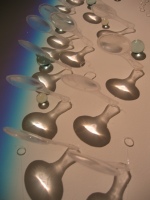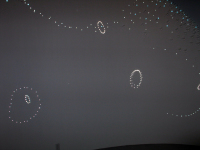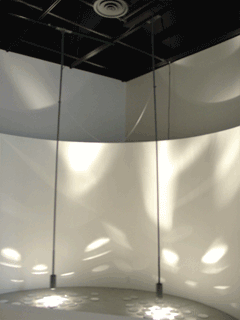Sweet Tangles: Charles Matson Lume at the Science Museum
Lightsey Darst speaks to Charles Matson Lume in the process of making his light-based installations for the Art and Science program at the Science Museum. It's basic magic, rich and strange.




In the lobby of the Science Museum what looks like a flooded pipe organ sends air bubbles shuttling up through long plastic tubes all the way to the high ceiling. Two ropes swing perpendicularly in the Museum’s front windows, their curves visibly moving yet appearing to remain in the same place. Over the box office a sculpture made up of many small triangles reflects light in strange, science-bright colors.
Looking at these strange art works, I have trouble deciding between law and chaos. “Aurora,” the light sculpture, is baby blue and pop tart pink in predictable order, each triangular tile yielding a different tint as I, the unpredictable element, move from side to side; it won’t change without me. “Double-Dutch,” the pair of swinging ropes, is carefully set up so that its “period matches its wave,” or something like that, to give it that look of moving and not moving; it’s a science experiment, and yet its just-controlled motion, coupled with its title, suggests to me an entirely different narrative. “Pipedream,” the bubble organ, sends its air bubbles up in symmetrical arrangements (vees and rows), but I like the moments when air bubbles fall back on each other in contained waterfalls. What am I supposed to enjoy? An artful use of natural law, or the occasional breaking through of something else? And why is that I feel more aligned with the break than with the order?
One more object occupies the lobby: an animatronic dinosaur. His snarl reminds me that I have something else to see.
On the lowest exhibition floor of the Science Museum I find Charles Matson Lume at work. He’s preparing to take down the second of three installations he will set up during his time as the Science Museum’s first artist in residence. As he takes out the boxes and bags the elements of his art will go back into, I admire the installation. On a curved wall two spotlights meet in a long Y of pale yet electric blue surrounding a gulf of darkness; the sides of this line of light are encrusted with magnifying lenses, translucent rubber bands, and clear marbles. This baroque tangle of light-reflectors also spreads across the wall in loose lines, spirals, and loops, some of which can’t be seen without the aid of a flashlight attached to a nearby table. I think of galaxies as I shine a light on a circle of rubber bands, galaxies within galaxies as I notice their individual egg-like shadows. The marbles cast a necklace of ethereal teardrop jewels on the wall; then I see cellular structures, luminous insides. The work is meditative, but what I meditate on keeps shifting between the inside and the outside, the human and the elemental.
Lume begins denuding the installation, peeling the glued magnifying lenses from the wall one by one. “I don’t have any lament when I take it down,” he says, in answer to my question. Sometimes he doesn’t remember the piece itself later, just the desire behind it: “I wanted to make it beautiful,” he says. It’s almost as if he’s practicing, like a brush painter or a dancer, performing each installation, dismantling it, and getting ready for the next one. I’ve wondered how dancers live with the idea that all their art produces no lasting artifact; I ask Lume how he feels, and he tells me that he wonders if he’ll be left at the end of his life with nothing but a lot of boxes of art supplies. Yet he doesn’t sound sad.
I look at light passing through marbles, at the phenomena, scientific laws I vaguely remember here turned to art. Lume knows the science by experiment; he tells me that he asked for the curved wall, wanting to play with its effect on light. The next installation will involve moving light, something he’s tried before but without the technology the Science Museum can supply. The engineers here can sketch out what he asks for in equations and diagrams, and they know how to calculate the effects of his art, the dimension of the light cast through a marble, but Lume is more interested in the effect than in the law behind it.
I watch a lone marble on the floor. When I was a kid I loved to group my marbles by color and then stare into their strange glassy worlds, to hold them up in front of light or to stare through them. Marbles were an early vision of transcendence, but the transcendence itself felt so small, so private that I never thought of sharing it with anyone. Lume, though, wants to show the tiny epiphanies hidden in his unremarkable materials. He doesn’t want to “expand” into giant installations with specially-made materials; using the Science Museum’s assistance is about as far as he’s willing to go that way. Instead, Lume wants to work with these marginalized materials, these ephemera, and wants to work with them by himself. He chooses materials for what’s hidden in them, as the irregular egg-shadows are hidden in the clear rubber bands and the scars of colored light are hidden in the marbles. It’s in keeping with this low-tech approach that his art is of brief duration. He carefully stows the magnifying lenses in a cardboard box labeled “art”.
I come back to watch Lume begin his next installation, in which two lights will swing over a pattern of small round mirrors on the floor. The lights from the previous installation are still up, and as he begins to arrange the mirrors wounds of light spring up on the wall—long tear-shapes with slightly ragged edges and the cool ripple of lake-water under a flashlight. I’m surprised, but Lume has seen these shapes before and they’re not what he’s after. Instead, he moves one of the hanging lights over the mirrors, and this time, high-definition double discs float over the wall. They’re flying saucers, skates in shallow water with their slightly up-curled edges, ladies’ hats or veils in a dark shop window; they’re spinning eyes, plates of smoke, or jellyfish moving coolly in the lagoon where you meant to swim, their luminous edges your only warning. I don’t understand why the reflection cast has two layers, or why it’s so crisply, surreally well-defined, but Lume explains that it’s because of the kind of bulb he’s using.
Lume thinks of the shapes as “blood cells” or “glass bells”; he imagines them chiming as they swing back and forth. We pick up our conversation where we left off and I write down some scattered phrases—“celestial,” “show on your car windows,” “being in the dark and not knowing.” Lume is as mystified by what he finds in the intersection of light and material as anyone, and he started using these materials, he explains, because they were more abstract and less easy to manipulate than paint or charcoal. You can’t make mirrors do whatever you want them to; they have a range of truth and nothing more. I ask Lume how he feels about being cut off from overt statement and topical art, whether the abstraction is ever frustrating. But he’s wary of the meanings one person’s mind can imagine: “I don’t want [the art] to be just me,” he says. He feels that love and death do enter his art, even if particular loves and particular deaths can’t.
Later I watch the finished installation by myself. Every so often the two lights are pulled backward by some invisible and to me magical force (a device arranged by the Science Museum’s engineers), then released, and they swing wildly over the mirrors for a few minutes, sending those strange discs flying across the wall, then settle down into slower and slower motion. With the overhead lights off now, I think of coins in water, scales on a fish, the shells called angel wings. The motion may be random, but it feels meaningful, as if each hovering disc were a communication from some very patient aliens. I wonder again why the shapes are so eerily distinct—not scientifically why, not about the phenomena, but I wonder about the universe itself. Why is it so detailed? For a moment it seems cruel to me that something so irrelevant as a mirror can make a shape that holds me expectant, that makes me think it is about to reveal a secret. In front of Lume’s work, I am intimate with, dependent on, something that doesn’t care about me at all. But the feeling I reach for in this flying light is also the feeling that holds me to my family and my husband—love that emerges wholly unfounded from our simple, ephemeral bodies.
I walk up the stairs and look down on the exhibition floors of the Museum. Children are running all over the place, pulling levers, hitting things, screaming at each other, running off again. I asked Lume what it was like to work with children all around him, and he told me of one encounter. “What are you doing?” the child asked. “I’m making art,” Lume answered. “Are you going to make a dinosaur?” asked the child. Most children aren’t concerned with art or science, at least not in the formal sense; they just want to see what they can make happen. In their carefree experimentation they’re like Lume, whose art, unlike the exhibits in the Science Museum’s lobby, isn’t about demonstrating known laws. He wants to know what he can do, not why he can do it. He tells me about seeing his little daughter, in an effort at running, fall flat on her face; “that’s just like making art,” he thought at once.
On the other hand, Lume is scientific in the deep sense: his art asks what’s at the center of the universe. He does not, like a scientist, answer that question with equations or theories. Instead, he uses light to open the least important things, our cast-offs, to show what’s inside. Are beauty, art, love, those sweet tangles, elements of the universe or creations of our minds? To this question Lume’s art replies: they are inborn—or, at the least, they are what happens when we look closely at our world.